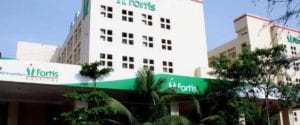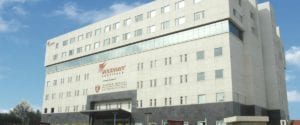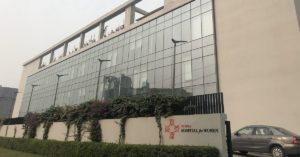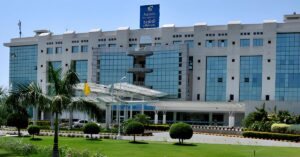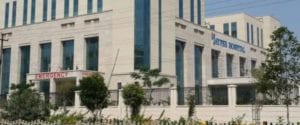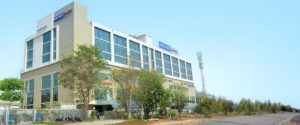Best Doctors in India for Neurofibromatosis Treatment
Best Hospitals in India for Neurofibromatosis Treatment
- City: Mumbai, India
Hospital Highlights:
- Fortis Hiranandani hospital was established in 2007.
- The hospital is an advanced tertiary care, multi-specialty hospital equipped with 149 beds.
- The hospital is equipped with a super ICU to provide emergency medical care to critically ill patients.
- The hospital is NABH accredited.
- The critical care facility in the hospital is augmented with the state-of-the-art facilities that facilitate speedier diagnosis and efficient monitoring.
- The hospital provides specialty medical services in cardiology, orthopedic science, pediatric science, neurology, diabetic care, urology, nephrology, ENT, obstetrics, gynecology, cosmetic surgery, bariatric surgery, neuro and spine care.
- City: Gurugram, India
Hospital Highlights:
- W Pratiksha Hospital, Gurugram, is one of the best hospitals in the NCR region. It is also a top hospital in India for IVF. Since its inception, the hospital has performed over 5500 successful IVFs. The hospital also specializes in gynecology.
- With over 20 years of experience in providing quality healthcare, the hospital is known as one of the most trusted and valued health providers in India.
- Equipped with world-class medical facilities and advanced technology, the hospital’s doctors and clinicians also have a track record of delivering excellent results. The hospital is also known for focusing on preventive well-being as much as on curative treatment.
- The hospital has earned the trust of its patients, by providing the best available treatments at affordable costs.
- City: Gurugram, India
Hospital Highlights:
- Paras hospital was established in 2006 and is the 250 bedded flagship hospital of Paras Healthcare.
- The is supported by a team of doctors of international and national repute.
- The hospital is NABH accredited and also the first hospital in the region to have a NABL accredited laboratory.
- The hospital provides specialty medical services in around 55 departments including Neurosciences, Joint Replacement, Mother & Child Care, Minimal Invasive Surgery, Gynecology and Obstetrics, Ophthalmology, Dermatology, Endocrinology, Rheumatology, Cosmetic and Plastic surgery.
- The hospital is equipped with state-of-the-art technologies.
- City: Kolkata, India
Hospital Highlights:
- Fortis Hospital, Anandapur, Kolkata is a world-class super-speciality equipped with the latest technologies in the medical world.
- The hospital is NABH accredited.
- This state-of-the-art facility specializes in cardiology and cardiac surgery, urology, nephrology, neurosciences, orthopaedics, digestive care, emergency care and critical care.
- The hospital, governed by integrated Building Management System (IBMS), has a pneumatic chute system, for quick vertical and horizontal transportation between floors, facilitating speedy transfer of patient specimens, documents, reports, and medicines to the concerned departments.
- The hospital also has a nephrology department with over 28 advanced dialysis units.
- City: Mumbai, India
Hospital Highlights:
- SL Raheja hospital is a 140-bed multi-specialty tertiary care hospital that is being managed by Fortis Healthcare Ltd.
- The hospital is a benchmark in healthcare and medical facilities in the neighborhood of Mahim & the western suburbs.
- L.Raheja Hospital, Mahim has one of the most effective ICU and Casualty care services.
- The hospital provides specialty medical services in Cardiology, Oncology, Neurology, Orthopedics, Mother & Child Care, and in Diabetes.
- City: Mumbai, India
Hospital Highlights:
- Wockhardt Hospitals were established in the year 1973, originally called First Hospitals and Heart Institute.
- Wockhardt Hospitals are super specialty health care networks in India, nurtured by Wockhardt Ltd, India’s 5th largest Pharmaceutical and Healthcare company.
- Wockhardt Hospitals is associated with Partners Harvard Medical International, an international arm of Harvard Medical School, USA.
- Wockhardt Heart Hospital performed India’s first endoscopic heart surgery.
- The hospital has a state-of-the-art infrastructure equipped with the latest technologies and modern equipment.
- It has special Centers of Excellence dedicated to the major specialties to provide hassle-free and high-quality clinical care.
- City: Gurugram, India
Hospital Highlights:
- The CK Birla Hospital in Gurugram is a NABH-accredited multi-specialty hospital.
- The hospital strives to increase the quality of healthcare by focusing on UK NHS nurse and midwife training requirements. Policies and practices derived from the National Institute for Health and Treatment Excellence (NICE) recommendations in the United Kingdom ensuring that a strong focus on safety, high-quality clinical care, and sanitation is maintained.
- The hospital’s cutting-edge technology and facilities allow for real-time communication and seamless collaboration among caregivers, ensuring accuracy and the best possible results. Those with foreign experience and accreditations make up part of the hospital’s team of clinicians.
- City: Ahmedabad
Hospital Highlights:
- As a member of the Apollo Hospitals Group, Apollo Hospitals International Limited, Ahmedabad is one of the most popular and sought-after medical facilities in Gujarat.
- Through its 6 Centres of Excellence and various affiliated branches, which cover all specialties and subspecialties, the hospital provides the most advanced clinical services.
- Since its inception in 2003, the hospital has been providing each patient with the most up-to-date medical equipment and state-of-the-art technology.
- With more than 150 successful organ transplants, including liver and renal transplants, the facility has been able to build a strong and extensive organ transplant program.
- In addition to performing 600 surgeries and caring for over 1800 patients on an IP basis, the hospital sees more than 18,000 patients on average in the outpatient department.
- With one of the biggest cardiology teams in the area, the hospital provides state-of-the-art regional care treatment in Cardiac Sciences.
- Additionally, the hospital offers a broad range of Neuro Interventional techniques to help stroke patients recover more quickly.
- City: Noida, India
Hospital Highlights:
- Jaypee Hospital is the flagship hospital of the Jaypee Group.
- This hospital has commissioned 525 beds in the first phase and has been planned and designed as a 1200 bedded multi-specialty facility.
- It holds the accreditation of the NABH and NABL.
- The hospital has state-of-the-art infrastructure equipped with the latest technologies and modern equipment like 64 Slice PET CT, Dual Head 6 Slice SPECT CT, Gamma Camera, and Da Vinci Robotic Surgery for comprehensive robotic surgical solutions.
- It has special Centers dedicated to the major specialties to provide hassle-free and high-quality clinical care.
- City: Mumbai, India
Hospital Highlights:
- Reliance Hospital is one of the best super-specialty care hospitals in Navi Mumbai.
- The main purpose of this hospital is to become a trustworthy place for the best health and hope for society. The hospital is well connected to the suburbs of Mumbai and Navi Mumbai.
- The hospital has various specialty departments, viz., Accident & Emergency, Anesthesiology, Dental Services, Dermatology, Diabetology, Dietetics Nutrition, Endocrinology, ENT, Gastroenterology, General Surgery, Gynaecology And Obstetrics, Hepato Pancreato Biliary Surgery, Infectious Disease, Internal Medicine, Interventional Radiology, Laboratory Medicine, Minimal Access Laparoscopic Surgery, Nephrology, Neurosciences, Opthalmology, Orthopaedics, Paediatrics, Pain Management Palliative Care, Physical Medicine Rehabilitation, Plastic And Reconstructive Surgery, Psychiatry, Pulmonary Medicine, Radiology, Rheumatology, Transplant, Urology Andrology, Vascular Surgery
Neurofibromatosis
Neurofibromatosis is an incurable genetic disorder that affects the entire nervous system. It can affect the development of nerve cell tissues. It also leads to tumors known as neurofibromas to develop on the nerves, which can lead to various other problems.
In some cases, they might be harmless but they might also cause serious damage if they compress the nerves as well as other tissues.
The disorder is of three types, i.e. Nf1, Nf2 and schwannomatosis, though they are not related.
Symptoms
The symptoms of neurofibromatosis can vary, depending on the type.
The disorder can spread throughout the whole body, causing tumors as well as unusual skin pigmentation. It can manifest as bumps as well, under the skin, colored sports, bone problems, pressure on spinal nerve roots, as well as other neurological problems.
In some cases, patients can also face learning disabilities, behavioral problems, or vision or hearing loss.
NF1 – When this type of neurofibromatosis affects an individual, he/she may show a skin condition but no other related medical problems. Birthmarks and freckles are common as well, among people with this condition. Freckles might appear at an unusual location, such as the groin, under the breasts, or in the armpits. People with this type of neurofibromatosis are also at a higher risk of hypertension or high blood pressure.
NF2 – NF2 is a more serious condition in which tumors grow on nerves deep inside the body. There might be several symptoms such as facial numbness, weakness, paralysis, hearing loss, loss of balance and vertigo, tinnitus, etc.
As the tumor grows, the symptoms might get worse. Tumors may also sometimes develop on the brain, skin, and spinal cord, with potentially serious consequences. Cataracts might also occur, as well as learning disabilities and behavioral problems. Tumor sometimes develops rapidly, but some grow slowly, and the effect might not be noticeable for several years.
Schwannomatosis – It is a rare form of neurofibromatosis, that generally affects less than 1 in 40,000 people. It is generally different from NF1 and NF2. This can cause pain, tingling, numbness, or weakness in the finger and toes.
Causes
The cause of neurofibromatosis is genetic defects or mutations that are either passed on by a parent or occur spontaneously during conception.
NF1- The NF1 gene is located on chromosome 17 and this gene produces a protein termed neurofibromin that helps regulate cell growth. The mutated gene causes a loss of neurofibromin, which allows cells to grow uncontrolled.
NF2- The NF2 gene is located on chromosome 22, and it produces a protein which is termed merlin, also called a schwannomin, which helps in suppressing tumors. The mutated gene can lead to a loss of merlin, lead which can cause uncontrolled cell growth.
Schwannomatosis- Two genes are generally known to cause schwannomatosis. Mutations of the genes SMARCB1 and LZTR1, which helps to suppress tumors, are associated with this type of neurofibromatosis.
Diagnosis
For NF1
Generally, NF1 is normally diagnosed during one’s childhood. A diagnosis is generally confirmed when an individual has at least two of the following:
- A family history of NF1
- Lesions in the bone
- A glioma, or tumor, on the optic nerve, which is mostly without symptoms
- At least six “café-au-lait” spots which measure over 5 millimeters across in children or 15 millimeters in adolescents or adults
- Freckling in the armpits, in the groin area, or under the breast
- At least two Lisch nodules, or small brown spots in the iris
- Two or more neurofibromas, or one “plexiform”
Plexiforms affect around 25 percent of people who have Nf1. Plexiforms are neurofibromas that spread around the large nerves as they grow, which leads to the nerve becoming thick and misshapen. They generally feel like knots or cords under the skin. They can be large as well as painful, and also disfiguring. Plexiform generally start forming during childhood.
A special type of lamp is used to check for any skin marks. Other diagnostic tools that your doctor can use include an X-ray, CT, or MRI scan. A genetic blood test might be required as well.
For NF2
Symptoms of NF2 generally appear around puberty or during adulthood. The most common age of onset is generally between 18 to 24 years.
Diagnosis of NF2 can be made when there is:
- An acoustic neuroma in one of the ears, along with two or more typical symptoms, such as cataracts, brain tumors, and a family history of the condition
- Acoustic neuroma along with brain or spinal tumors, which can be detected by an MRI or CT scan
- An acoustic neuroma in both the ears
- A faulty gene, which is identifiable through a blood test
A person having NF2 will be referred to a neurologist. Hearing and eye tests might also be conducted to check for cataracts, other eye problems, and hearing problems.
Treatment
Since there is no permanent cure for neurofibromatosis, treatments generally focus on the symptoms. Some of the symptoms generally do not need any treatment. Some of the options for treatment can include the following:
- Surgery for removing problem growths or tumors
- Treatment which can include chemotherapy or radiation if a tumor has turned malignant, or cancerous
- Surgery for bone problems, such as scoliosis
- Therapy which can include physical therapy or counseling
- Surgery for cataracts
- Auditory brainstem and cochlear implants
- Aggressive treatment of pain linked to the condition
- Stereotactic radiosurgery

